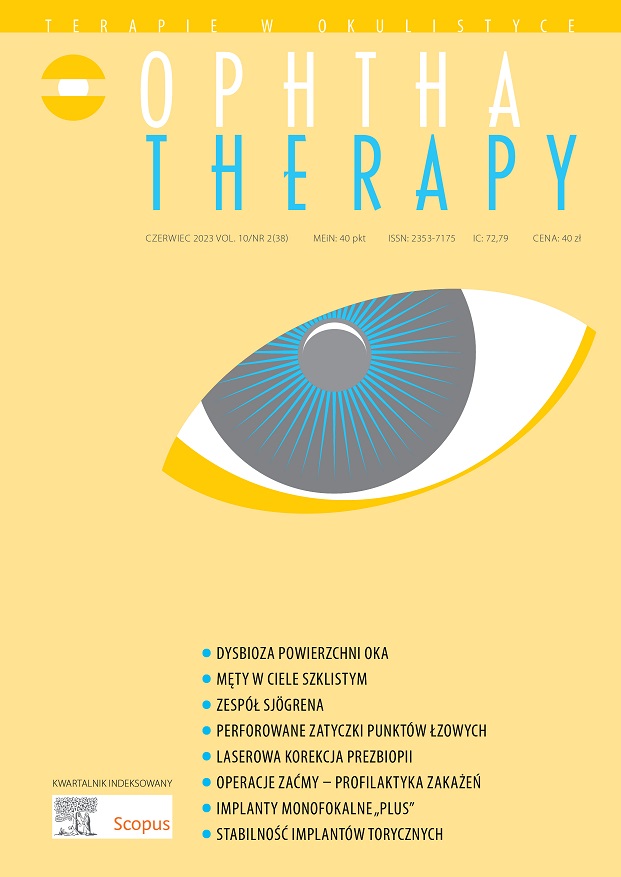Influence of laser correction of presbyopia using the Presbyond? Laser Blended Vision (LBV) method on the contrast sensitivity Review article
Main Article Content
Abstract
Presbyond? Laser Blended Vision (LBV) method, based on the FemtoLASIK technique, is currently the most frequently performed laser refractive procedure to correct presbyopia. This method involves the non-linear aspheric ablation of the cornea with controlled induction of spherical aberrations in both eyes and the induction of micromonovision of -0.75 to -1.50 D in the non-dominant eye. The article presents the results of published studies analyzing the effect of laser correction of presbyopia using the Presbyond? LBV method on the contrast sensitivity. The studies published so far indicate that the Presbyond? LBV treatment does not significantly affect contrast sensitivity.
Downloads
Article Details

This work is licensed under a Creative Commons Attribution-NonCommercial-NoDerivatives 4.0 International License.
Copyright: © Medical Education sp. z o.o. License allowing third parties to copy and redistribute the material in any medium or format and to remix, transform, and build upon the material, provided the original work is properly cited and states its license.
Address reprint requests to: Medical Education, Marcin Kuźma (marcin.kuzma@mededu.pl)
References
2. WHO. Vision 2020. Global initiative for the elimination of avoidable blindness. Fact Sheet No 1213. Geneva: WHO, 2000.
3. Reilly CD, Lee WB, Alvarenga L et al. Surgical monovision and monovision reversal in LASIK. Cornea. 2006; 25(2): 136-8. http://doi.org/10.1097/01.ico.0000178722.19317.7b.
4. Levinger E, Trivizki O, Pokroy R et al. Monovision surgery in myopic presbyopes: visual function and satisfaction. Optom Vis Sci. 2013; 90(10): 1092-7. http://doi.org/10.1097/OPX.0000000000000002.
5. Garcia-Gonzalez M, Teus MA, Hernandez-Verdejo JL. Visual outcomes of LASIK-induced monovision in myopic patients with presbyopia. Am J Ophthalmol. 2010; 150(3): 381-6. http://doi.org/10.1016/j.ajo.2010.03.022.
6. Reinstein DZ, Couch DG, Archer TJ. LASIK for hyperopic astigmatism and presbyopia using micro-monovision with the Carl Zeiss Meditec MEL80 platform. J Refract Surg. 2009; 25(1): 37-58. http://doi.org/10.3928/1081597X-20090101-07.
7. Rocha KM, Vabre L, Chateau N et al. Expanding depth of focus by modifying higher-order aberrations induced by an adaptive optics visual simulator. J Cataract Refract Surg. 2009; 35(11): 1885-92. http://doi.org/10.1016/j.jcrs.2009.05.059.
8. Montés-Micó R, Charman WN. Mesopic contrast sensitivity function after excimer laser photorefractive keratectomy. J Refract Surg. 2002; 18(1): 9-13. http://doi.org/10.3928/1081-597X-20020101-01.
9. Lackner B, Pieh S, Funovics MA et al. Influence of spectacle-related changes in retinal image size on contrast sensitivity function after laser in situ keratomileusis. J Cataract Refract Surg. 2004; 30(3): 626-32. http://doi.org/10.1016/j.jcrs.2003.08.032.
10. Elliott DB. Contrast sensitivity decline with ageing: a neural or optical phenomenon? Ophthalmic Physiol Opt. 1987; 7(4): 415-9.
11. Nomura H, Ando F, Niino N et al. Age-related change in contrast sensitivity among Japanese adults. Jpn J Ophthalmol. 2003; 47(3): 299-303. http://doi.org/10.1016/s0021-5155(03)00011-x.
12. Datta S, Foss AJ, Grainge MJ et al. The importance of acuity, stereopsis, and contrast sensitivity for health-related quality of life in elderly women with cataracts. Invest Ophthalmol Vis Sci. 2008; 49(1): 1-6. http://doi.org/10.1167/iovs.06-1073.
13. Reinstein DZ, Archer TJ, Gobbe M. LASIK for Myopic Astigmatism and Presbyopia Using Non-Linear Aspheric Micro-Monovision with the Carl Zeiss Meditec MEL 80 Platform. J Refract Surg. 2011; 27(1): 23-37. http://doi.org/10.3928/1081597X-20100212-04.
14. Reinstein DZ, Carp GI, Archer TJ et al. LASIK for presbyopia correction in emmetropic patients using aspheric ablation profiles and a micro-monovision protocol with the Carl Zeiss Meditec MEL 80 and VisuMax. J Refract Surg. 2012; 28(8): 531-41. http://doi.org/10.3928/1081597X-20120723-01.
15. Reinstein DZ, Ivory E, Chorley A et al. PRESBYOND Laser Blended Vision LASIK in Commercial and Military Pilots Requiring Class 1 Medical Certification. J Refract Surg. 2023; 39(1): 6-14. http://doi.org/10.3928/1081597X-20221129-02.
16. Lim DH, Chung ES, Kim MJ et al. Visual quality assessment after presbyopic laser in-situ keratomileusis. Int J Ophthalmol. 2018; 11(3): 462-9. http://doi.org/10.18240/ijo.2018.03.17.
17. Zhang T, Sun Y, Weng S et al. Aspheric Micro-monovision LASIK in Correction of Presbyopia and Myopic Astigmatism: Early Clinical Outcomes in a Chinese Population. J Refract Surg. 2016; 32(10): 680-5. http://doi.org/10.3928/1081597X-20160628-01.
18. Brar S, Sute SS, Bagare SN et al. Functional Outcomes and Reading Speeds following PRESBYOND LBV Using Nonlinear Aspheric Ablation Profiles Combined with Micro-Monovision. J Ophthalmol. 2021; 2021: 2957443. http://doi.org/10.1155/2021/2957443.
19. Romero M, Castillo A, Carmona D at al. Visual quality after presbyopia correction with excimer laser ablation using micromonovision and modulation of spherical aberration. J Cataract Refract Surg. 2019; 45(4): 457-64. http://doi.org/10.1016/j.jcrs.2018.10.048.

